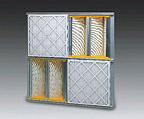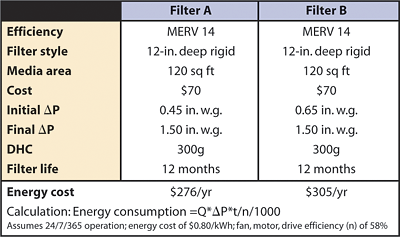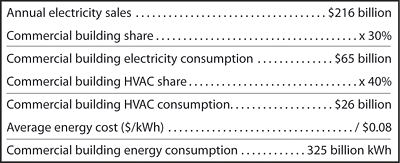
While rising energy costs are certainly not new (anyone remember the 1970s?), the ways that businesses and individuals deal with rising energy costs is new. Since the crisis of the 1970s, the U.S. economy has shifted to less energy-intensive industries and has adopted more energy-efficient technologies. From energy-efficient appliances and office equipment to fuel-efficient hybrid vehicles, new energy-efficient products and technologies are available for all facets of personal, commercial, and industrial use.
For commercial buildings specifically, energy use is projected to grow by 1.7% per year until 2025, according to the DOE. This is slightly faster than the projected growth rate for commercial floor space of 1.5%. The DOE goes on to note that energy efficiency standards, voluntary government programs aimed at improving efficiency, and other technology improvements are expected to balance the effects of a projected increase in demand for electricity-based services, meaning that energy consumption per square foot of commercial office space is projected to show little increase.
So, while the news for building owners and managers is not completely bad, it's also not completely good, especially in the face of declining operating budgets. For example, one area that facility managers should take a look at for energy savings opportunities are HVAC systems, which continue to be a source of high energy costs in commercial buildings.

HVAC Systems and Energy Efficiency
HVAC systems account for approximately 40% of the energy used in U.S. commercial and residential buildings. This creates a prime target for cost reductions as building designers, owners, and operators look to energy-efficient building designs and technologies as methods of cutting costs and saving on the annual operating budget. Adopting such energy-efficient design and technologies (not just in HVAC, but in other areas such as lighting, windows, roofing, and insulation) for new office buildings can cut energy costs by as much as 50% , according to the DOE. In existing buildings, renovations that replace older systems with more efficient technology can yield savings of up to 30%.The DOE goes on to note that a quick way to realize savings of 10% or more - at little or no cost - is to effectively operate and maintain existing systems. HVAC systems are an ideal candidate for this type of effort. Even better news: effectively operating and maintaining an existing HVAC system can provide additional benefits such as improved tenant comfort and IAQ, which can have significant returns with respect to tenant satisfaction and reduced tenant turnover.
There are a number of things facility managers can do to make sure they're effectively operating and maintaining HVAC systems. Begin by reviewing ASHRAE Standard 90.1, Energy Standard for Buildings Except Low-Rise Residential Buildings. This sets the minimum energy efficiency required by most building codes. To take the standard even further, ASHRAE, in conjunction with the American Institute of Architects (AIA), is working to develop Advanced Energy Design Guides, which will help building system designers achieve an additional 30% energy savings over ASHRAE Standard 90.1. As of this writing, the first of the guides, which would apply to office buildings up to 20,000 square feet, is still in development.
A review of HVAC energy efficiency may show that systems are substantially oversized. In fact, according to the Consortium of Energy Efficiency, at least 25% of all rooftop HVAC units are oversized, resulting in increased energy costs and equipment wear. While undersized HVAC equipment may not provide optimum occupant comfort, oversized HVAC equipment costs more up-front, uses more energy to run, and is not as effective in heating, cooling, and moisture reduction.
In addition to "right-sizing" of HVAC equipment, the energy efficiency experts at Energy Star® recommend regular HVAC system maintenance - at the very least they recommend "pre-season" tune-ups before each cooling and heating season. Another energy-saving tip from Energy Star is to install a programmable thermostat to automate the HVAC system. This device turns the HVAC on and off based on temperature, not whether the building is occupied, and according to Energy Star, can cut HVAC costs by about 30% for small businesses.

Using Filters to Conserve Energy
In addition to removing the contaminants from the air that passes through the system to the building occupants and also protecting the HVAC equipment from dust, filters play a significant role in the energy consumed to operate the system. The energy used is based on the resistance of the air passing through the filter. Therein lies the opportunity for filters to be used as a method of energy conservation, because the lower the filter's resistance, the lower the energy consumption will be. However, even though one speaks of filters, it is really the filter media that has the biggest impact in these areas: providing clean air, protecting equipment, and minimizing energy consumption.Unfortunately, some look at the media used in their filters as a commodity that provides little differentiating performance value. Recent advances in filtration media technology show that this is not the case at all. However, because of the perceived commodity status, price has become the determining factor for building owners and managers when determining what type of filter and media to use. It's important to understand, though, that the cost of energy used by filters far outweighs the initial cost of the filter itself. In fact, energy costs can be 10 times the initial filter cost for a standard pleated filter and 4 to 5 times the initial filter cost for higher-efficiency final filters. Therefore, with filters controlling a majority of an HVAC system's energy consumption and thus a majority of its operating cost, one could look to the filter itself as a method of conserving energy.
Fortunately, there is a way to use filters as an energy conservation tool. That is to consider the total life-cycle cost of the filter and the long-term impact on energy costs that a particular filter will have. More energy-efficient filters do not necessarily cost more, so energy savings can often be achieved without any investment at all. Life-cycle costs, energy costs, and filter pressure drop should all come into play during the filter selection process. ASHRAE supports this position, stating in its ASHRAE Energy Position Document (2003) that failure to recognize and accommodate the life-cycle impacts of improved efficiency (e.g., focusing on first cost) is a market barrier to be addressed in improving the energy efficiency of buildings.
The three major components of life-cycle cost for HVAC filters are initial investment and maintenance, energy consumption, and disposal. On average, energy cost accounts for an astounding 81% of the total life-cycle cost of a filter system. The initial investment and maintenance accounts for 18%, and disposal accounts for 1%.
It is obvious from the numbers that energy provides the biggest opportunity for cost savings. Table 1 verifies these numbers for several types of filters.
How can life-cycle costs of filters be applied to energy efficiency? Development of new materials has given the filter industry a chance to produce lower pressure-drop media while maintaining high particle capture efficiencies, thereby providing the ability to improve IAQ and reduce electricity costs simultaneously. Electret technology and electrostatic filter media have been the key technologies enabling this seemingly contradictory concept to become a reality. Switching to a lower pressure-drop filter is one of the easiest changes for building owners and facility managers to make in an effort to reduce energy costs. That's because, with a lower pressure drop filter, the HVAC system motor needs to overcome less resistance to deliver the required airflow, thus reducing the motor's energy consumption.
Table 2 illustrates the impact of a filter's pressure drop on annual energy costs. Note that the two commercially available filters are identical except for the initial pressure drop. In a typical scenario, one might use initial cost as the primary criteria in choosing one of these filters over the other. However, as the example shows, this might not result in the correct filter choice for maximizing long-term cost savings. In this example, initial costs are the same to illustrate the impact of pressure drop on operating costs.
Filter A provides lower initial and average pressure drops and therefore saves approximately $29 in energy costs annually. While an energy cost savings of $29 per year may not sound like a lot, keep in mind that those cost savings are per filter, not for an entire HVAC system. Another way to look at the information is to consider that $29 saved with Filter A offsets 41% of the initial filter price.

The Macroscale Impact of Filters on Energy
From a macroscale standpoint, the overall impact of energy consumed by commercial building HVAC systems can be estimated by considering that commercial buildings account for just over 30% of the energy consumption in the U.S., and that heating and cooling accounts for 40% of a commercial building's total electricity bill. This is illustrated by Table 3.The impact of a change in filter pressure drop on total energy consumption can be estimated by assuming that the average pressure drop in every commercial building filter is reduced by 0.025 in. w.g. Assume it changes from 0.700 in. w.g. to 0.675 in. w.g. in this example. By applying a simple ratio to the energy formula, the total energy used in the reduced pressure drop scenario is 313 billion kWh. At an energy cost of $0.08/kWh, this results in a 12 billion kWh energy savings, which in turn translates into cost savings of $960 million. To put this into perspective, filter manufacturers and distributors would have to reduce prices on all filters by approximately 50% to provide this level of cost savings potential to facility managers and building owners.
Most building owners and facility managers would agree that filtration efficiency comes first. Beyond the MERV or efficiency rating, buyers and specifiers often use filter price as the next decision-making criterion. However, after examining life-cycle cost data and energy savings data, it is evident that the key criterion should be energy consumption, as indicated by the initial pressure drop of the filter. Building owners and facility managers considering the energy costs of various filter technologies should ask their filter supplier the following questions:
- What pressure drop reduction offsets the difference in filter price?
- At what pressure drop reduction would a filter upgrade pay for itself?
- At a given performance level, how much money could be saved by using a lower pressure drop filter?
- How much of my filter costs does that cost-savings offset?
Remember to ask your filter supplier for life-cycle cost tools and energy cost calculators to help in determining the economic impact of various equally performing filters.

Conclusion
The lowest-cost air filtration system is dependent on many factors, including investment and maintenance costs as well as "hidden" costs such as energy, disposal, and shrinkage due to damage. Energy is the main component of the cost equation, accounting for about 81% of the cost of the filter system. Despite this fact, most of the focus is placed on the initial price of the filter during the selection process. New nonwoven media technologies enable filters to achieve high filtration efficiencies while maintaining low-pressure drops. Contrary to industry beliefs, higher filtration efficiency no longer means higher pressure drop. There are commercially available 95% efficiency synthetic media filters that have the same pressure drop as 65% efficiency glass media filters, providing the ability to increase filtration efficiency by 30% without increasing energy costs at all.In short, better filtration does not always result in higher total costs, and at an equivalent efficiency level, there are significant opportunities to save costs that extend beyond the initial price of the filter. For endusers, focusing on total life-cycle costs vs. initial price, and maximizing filtration efficiency while minimizing pressure drop will allow you to reap the largest value for your organization and will help you achieve "filtration nirvana" - good IAQ, reduced equipment maintenance, and the lowest possible energy costs. ES
